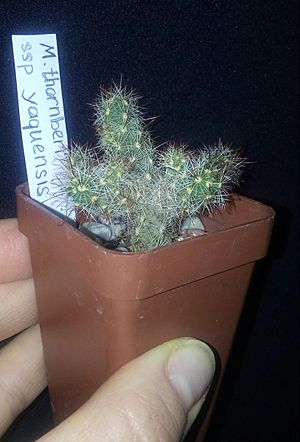Thornber's fishhook cactus facts for kids
Quick facts for kids Thornber's fishhook cactus |
|
|---|---|
 |
|
| Conservation status | |
| Scientific classification | |
| Genus: |
Mammillaria
|
| Species: |
thornberi
|
The Mammillaria thornberi is a special type of cactus. People often call it the Thornber's fishhook cactus or Thornber's nipple cactus. This cool plant grows naturally in Arizona, USA, and in Sonora, Mexico.
Contents
What Does This Cactus Look Like?
This cactus grows in clumps, meaning many stems grow together from the same plant. Each stem can root into the ground, making a big group.
Stems and Spines
The stems are shaped like cylinders. They usually grow up to 10 centimeters (about 4 inches) tall. Some can even reach 30 centimeters (about 12 inches)! Each stem is about 3.5 centimeters (1.4 inches) wide.
On each stem, you'll find small bumps called areoles. From these bumps, spiky things grow. There can be up to 21 thin, bristle-like spines around the edge. In the middle, there are one to three special spines that look like tiny hooks.
Flowers and Fruit
The flowers of the Thornber's fishhook cactus are pretty. They can be up to 3 centimeters (1.2 inches) wide. Their inner "petals" (called tepals) are white or pink. They often have a pink stripe down the middle. These flowers usually bloom after a good rain.
After the flowers, bright red fruits appear. These fruits can be up to 1.5 centimeters (0.6 inches) long. Guess what? They are safe to eat! Inside the fruit, you'll find small black seeds.
Where Does This Cactus Live?
This cactus likes to grow in desert areas. It often grows under other plants, which are called nurse plants. These nurse plants help protect the young cactus from the hot sun and strong winds. For example, it often grows under a plant called Ambrosia dumosa.
Cactus Homes in Arizona and Mexico
You can find this cactus in desert scrub habitats. In Arizona, there are two main places where it grows. One area is in the Avra Valley and Saguaro National Monument. The other is on the Tohono Oʼodham Indian Reservation. It also lives in Sonora, Mexico.
A Look at Its Past
Long ago, before the 1930s, there were many of these cacti in the Avra Valley. But then, a very cold freeze happened. This freeze hurt a lot of the plants. Now, there are only about 600 of these cacti left in all the known places combined. Protecting them is important!


